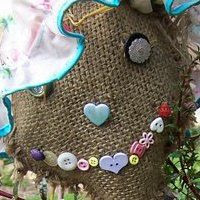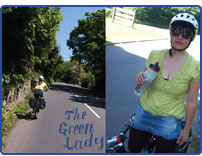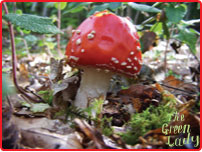 |
| Green and red dogwood decorating the rustic fence and made into a wreath with some willow. |
 |
| The wildlife area. The tree supports a huge mass of ivy which is a perfect nesting site. |
 |
| Bundles of dogwood cuttings for the children to play with on the left, cuttings that I later planted on the right. |
 |
| Red dogwood and willow stems. |
 |
| Bundles of sticks to attract insects. |
 |
| A willow arch that I pruned and tidied up and the primroses and daffodils planted by the children. |
Previously when I've worked here I've had small groups of children come out to help. Then at play time and lunch time I had kids swarming round me desperate to do something and I would try and find jobs for as many as possible without creating total chaos. Their enthusiasm should be encouraged. This time I wanted to work alone so that I could get a number of jobs finished quickly. Ideally the children would have complete control of the garden by training up some to oversee regular maintenance jobs. Unfortunately there is still an attitude that the garden is a special out of bounds place. My son told me "we're not allowed in there". I hope the attitude of staff changes but it may take some time and gentle encouragement.
My first job was cutting back a red-barked, leggy, neglected dogwood bush: Cornus alba 'Sibirica'. They should be pruned just before they bud in March/April. I pruned the dogwood to about 4" from the ground and saved as much of the bright red stems as I could. The new shoots are needed for the beautiful burning colour.
Why do I love dogwood so much? I love to use natural, sustainable materials in craft projects and dogwood is just perfect for this. You can make fences, wreaths, baskets, stars, picture frames. The stems are incredibly soft with an almost rubber quality to them which will bend and wrap easily. A perfect shrub for school grounds, if there are enough of them you can be harvesting big bundles of stems to use as part of the outdoor learning experience. Along with the green-barked variety (Cornus stolonifera 'Flaviramea') and willow plantings you will have a variety of stems that can be used cut and also rooted in the ground for living structures and sculptures. Soak the cut stems in water for a while if they become too stiff to use. Dogwoods are often planted by councils in parks and next to roadsides (they are incredibly tough) so you can harvest your craft materials for free. As long as you use sharp secateurs and don't take too much. Always cut just above a bud.
They are also easy to propagate to create more plants. Cut stems that are about a pencil thick just below the nodes (where the leaves grow from the stem) at the bottom and just above the nodes at the top. Cut the top on a slant so you know this is the top when planting. Stems should be roughly 10-12" long. Plant the cuttings up to 2/3 deep in some moist, well drained soil. They need to go in this deep to stop wind damage. Plant about a foot and a half apart. I was very lucky to get a bundle of cuttings all ready prepared for me (like on a TV show) by the lovely Tony, head gardener at Fairlight Hall.
When working at a community garden or school garden It really helps to befriend people who are working on large gardens and estates because it's amazing the amount of re-usable vegetation they will create or spare plants and seedlings they will have and will often be happy to donate. Ideally there would a connection between the council, schools, community gardens and estates. A number of jobs could be created and it would save lots of money.
I planted the cuttings in a circle in the field while flecks of snow were falling like little white feathers. Then covered them with the bark chippings I persuaded the council to deliver. It is a water-logged area of the field. I plan to buy some willow whips to add to the circle. This extended winter weather has bought me some extra planting time which is great.
I have also finished the grant application which will be sent in this week to the Big Lottery. Please keep your fingers crossed for us. It would enable the school to renovate woodland that at the moment is closed off by a large fence and has rubbish thrown into it and has been used for drug taking. When I was at school I remember looking through the playground fence to a marshy wooded area that had little wooden paths through it. I don't ever remember being allowed to go there and I longed to be able to play there. Thirty years later not much has changed with most school playgrounds. I was lucky that I was taken to the woods and countryside regularly by my parents and when I was older was able to play unsupervised in woods near my house. Very few children have this experience now.
At playtime a boy asked what I was doing. I showed him the wreath I was making then showed him how to do it. I left a bundle of cuttings for the children to come and find on their own and told the boy to show his friends how to make the wreaths. When I visited a few days later I noticed the stems had been disturbed and there were a few new wreaths. Evidence that the children are feeling more at home in the wildlife area too.
For further information on creating a wildlife garden visit the RSPB's page here: wildlife friendly gardens.
Here is another great resource with lots of advice for encouraging wildlife: wildlife gardening pack.














